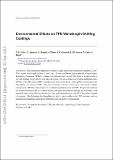Environmental effects on TPB wavelength-shifting coatings
Author(s)
Chiu, C. S.; Ignarra, Christina; Bugel, Leonard G.; Chen, H.; Conrad, Janet; Jones, Benjamin James Poyner; Katori, Teppei; Moult, Ian James; ... Show more Show less
DownloadConrad_Environmental effects.pdf (691.9Kb)
OPEN_ACCESS_POLICY
Open Access Policy
Creative Commons Attribution-Noncommercial-Share Alike
Terms of use
Metadata
Show full item recordAbstract
The scintillation detection systems of liquid argon time projection chambers (LArTPCs) require wavelength shifters to detect the 128 nm scintillation light produced in liquid argon. Tetraphenyl butadiene (TPB) is a fluorescent material that can shift this light to a wavelength of 425 nm, lending itself well to use in these detectors. We can coat the glass of photomultiplier tubes (PMTs) with TPB or place TPB-coated plates in front of the PMTs. In this paper, we investigate the degradation of a solution-based, embedded TPB coating in a laboratory or factory environment to assess the viability of long-term TPB film storage prior to its initial installation in an LArTPC. We present evidence for severe degradation of this type of coating due to common fluorescent lights and ambient sunlight in laboratories, with potential losses at the 40% level in the first day and eventual losses at the 80% level after a month of exposure. We determine the degradation is due to wavelengths in the UV spectrum, and we demonstrate mitigating methods for retrofitting lab and factory environments.
Date issued
2012-07Department
Massachusetts Institute of Technology. Department of Physics; Massachusetts Institute of Technology. Laboratory for Nuclear ScienceJournal
Journal of Instrumentation
Publisher
Institute of Physics Publishing
Citation
Chiu, C S, C Ignarra, L Bugel, H Chen, J M Conrad, B J P Jones, T Katori, and I Moult. “Environmental Effects on TPB Wavelength-Shifting Coatings.” Journal of Instrumentation 7, no. 07 (July 4, 2012): P07007–P07007.
Version: Original manuscript
ISSN
1748-0221